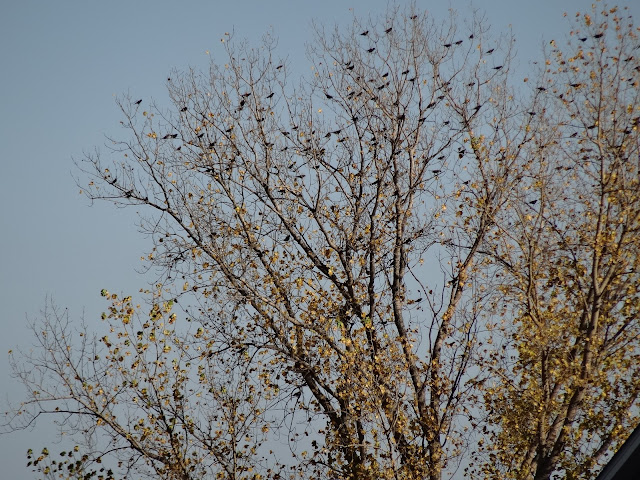1/30/2022
eagle nest, January
The eagle nest near the pond is again claimed as home for a pair of Bald Eagles Haliaeetus leucocephalus. One was in the nest for a while before this, probably rearranging sticks to her liking in preparation to lay eggs.
1/19/2022
FeederWatch, Downy Woodpecker
FeederWatch, a citizen-science program of Cornell University Lab of Ornithology, is once again an activity for me through the cold winter months. This small Downy Woodpecker Dryobates pubescens comes every day to feed at the suet block hanging near the pond. Suet supplements his regular diet of insects which he searches for between folds of tree bark. His tail feathers are strong and positionable to support him on tree branches or wherever he finds food.
1/06/2022
new year 2022 Juncos
Dark-eyed Juncos made their sudden winter appearance several weeks ago. In Springtime, they find mates and nest "up north" in Canada. In Autumn they migrate to places across the US where they spend the colder months. Junco hyemalis are flashy little sparrows. I think they look as if they're wearing tuxedoes, with crisp markings -- a white chest and belly, dark gray or black back, and pink bill. They have bright white tail feathers which they reveal as they flit around on the ground searching for seeds. Juncos flock together in winter, sometimes with others species. When they find a stash of seeds (like this dish on the deck overlooking the pond) they grudgingly takes turns at it.
12/26/2021
stars on ice
Another interesting feature of winter on the pond is the 'ice star' or 'lake star'. In my search for information about these patterns, I found many theories -- all related to the physics of temperature, moisture, pressure, and ice formation. One of these theories is that patterns are formed in early winter when a hole allows water to swell up from beneath and spread over the surface, leaving dark fingers of melted ice radiating from the hole.
12/23/2021
ice holes on pond
Cold, grey, blustery weather on the pond.
The water is covered by a thick layer of ice and snow drifts. Where the ice is visible between the drifts, a few holes break the smooth solid sheet. These seem to form where plant matter floating close to the surface or a submerged rock interrupted the process of liquid freezing to solid.
12/12/2021
12/09/2021
mud nest on maple twig
Walking in the winter always brings surprises! Without leaves on the trees, secret nests are revealed.
11/24/2021
song sparrow feederwatch
Song Sparrows Melospiza melodia live year around in the area around this pond, hiding their nests in grasses, weeds, or small trees.
Song Sparrows flit through dense, vegetation or low branches, staying low and forage secretively. They eat insects in the summer; in winter they switch to seeds and fruit they glean from standing plants.
They will also visit bird feeders. I notice them especially on 'count days' for FeederWatch.
11/23/2021
feederwatch 2021-2022
The pond is surrounded by grasses, wildflowers, and shrubs that provide food for birds. And we also put out seed and suet in feeders to bring the birds a little closer.
11/14/2021
log in first snow
Overnight, we had the first snow of this season. On the pond, the water is high and the log was frosted with a little coat of white 'frosting'. The reeds are still green, but weakening and leaning sideways with the weight of moisture. The turtles who sun themselves on the log in summer are hibernating now. (see Surviving Below Freezing, 10/31/2020)
11/08/2021
leaf galls
This fallen leaf has galls all over it, lumps or complicated structures that look like capsules containing something mysterious. Galls are made by one of 1500 species of gall producers -- mostly insects and mites. Some galls form on leaves where insects feed on the plant matter, or lay eggs. Galls may also develop as a response to infections by fungi, bacteria, or viruses. Dissecting the gall is the only sure way to tell what caused it. That's a whole different adventure!
11/02/2021
leaf veins
I can't resist looking closely at leaves. Sometimes, I take the interesting ones with me for later study. This maple tree next to the pond always has some message or lesson for me.
Today it displayed nice autumn color. But later I studied the veins that give the maple leaf it's unique shape. Not only does venation give each leaf it's biomechanical strength to grow and stay on the tree through all kinds of weather all summer long! Veins also function as transport vessels.The leaf is a main component in the plant's hydraulic system to move water and nutrients from the ground throughout the tree.
The larger veins provide immense leaf structure support, and the various smaller veins provide photosynthetic gas exchange and enable the plant's growth.
10/25/2021
muskrats chasing ducks
10/20/2021
mallards showing off
10/18/2021
black birds roosting
10/08/2021
10/05/2021
pond lily
How nice to have a pond lily! We anticipated seeing it bloom next season. The little plant was happy in this pond, spreading out its leaves to soak up the sun and give the tuber in the mud oxygen through the underwater stems.
10/01/2021
9/26/2021
9/24/2021
boneset, golden in autumn
9/23/2021
vervain, golden in autumn
9/22/2021
golden alexanders, golden in autumn
Among the yellow, purple, and white flowers in the riparian area surrounding the pond, the Golden Alexanders Zizia aurea have long gone to seed.
They bloomed a sunny yellow in May and June. Now, the seeds still stand in umbels on strong stems. The entire plant material remaining turns a golden purple-tinged color -- lovely among the autumn asters.
9/20/2021
purple asters
9/18/2021
seed harvest
Birds are already pecking out the sunflower seeds (top) and goldenrod flowers are releasing each seed with pappus, a tuft of hair that helps it disperse in breezes (bottom).






























